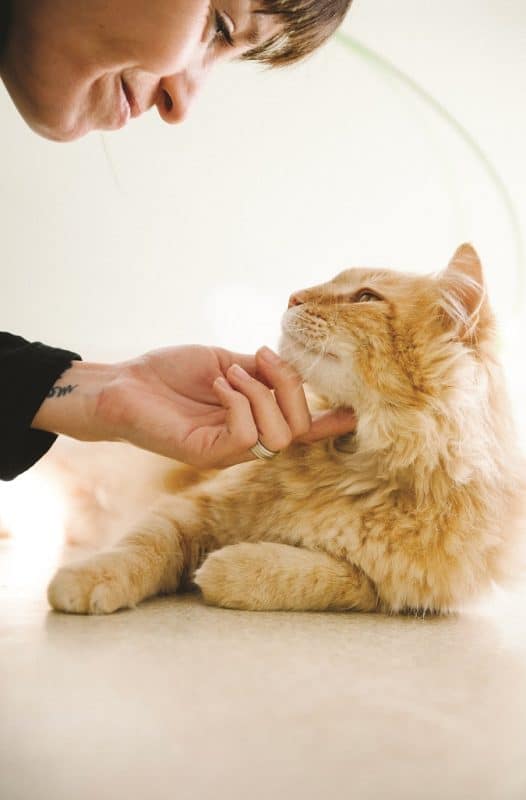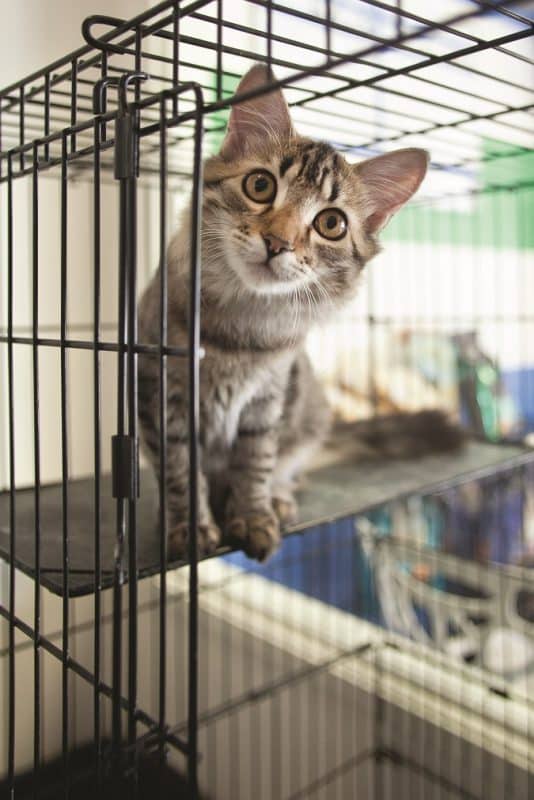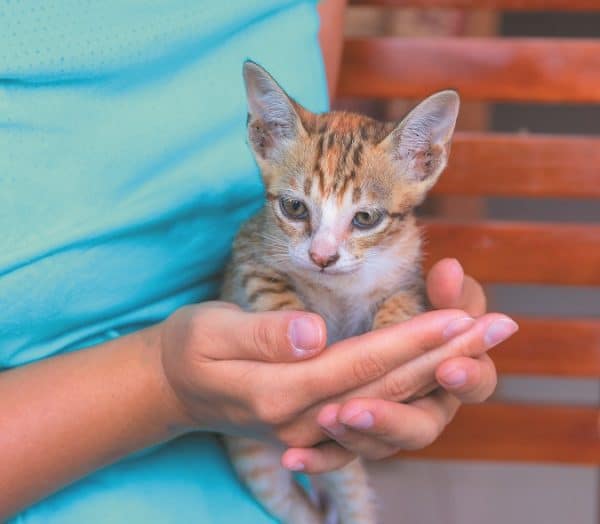The post Volunteer, Foster, Save a Life by Caroline Golon appeared first on Catster. Copying over entire articles infringes on copyright laws. You may not be aware of it, but all of these articles were assigned, contracted and paid for, so they aren't considered public domain. However, we appreciate that you like the article and would love it if you continued sharing just the first paragraph of an article, then linking out to the rest of the piece on Catster.com.
Last summer I received a text from my cat sitter who also runs a cat rescue: “Hey. I have nine kittens that need a place to crash for a few weeks. Can you help?” I panicked for a minute. I wanted to say yes, but I had no idea how to foster kittens, and we already had a houseful of resident pets. But the kittens had nowhere to go, so I agreed. In the end, my family and I were amazed at how easy (and fun!) it was to care for and socialize the little cuties and prepare them for their forever homes. Although we were clueless going into it, our first foster assignment was a smashing success.
WHY FOSTERING SAVES LIVES
Animal welfare organizations agree that a vital element of saving animal lives is fostering, which is when an individual or family takes in a pet from a shelter or rescue and cares for him, either for a short period of time or until the pet is adopted. According to the ASPCA, an estimated 3.2 million cats enter animal shelters across the country each year. Approximately 860,000 (more than 25%) of those cats are euthanized, many unnecessarily, due to lack of space or resources.
But animal welfare experts believe that fostering can change that ratio. “If just 2% of petowning households would foster one pet a year, we would end unnecessary euthanasia tomorrow,” says Susanne Kogut, president of the Petco Foundation, a nonprofit that has invested more than $250 million to support the lifesaving activities of animal welfare organizations nationwide.

Types of cats that need to be fostered (kittens, adults, seniors, those with health challenges) and amounts of time needed for fostering vary (overnight, two weeks, a month).
And Susanne knows from experience. In 2005, when she was tapped to lead the Charlottesville- Albemarle SPCA in Charlottesville, Virginia, the shelter had a fairly high euthanasia rate. To reduce this, Susanne and her team launched a foster program and soon, 40% of the animals the organization took in went to foster homes while awaiting adoption. Foster families freed up space and resources and ultimately eliminated unnecessary euthanasia at the shelter. “Fostering works,” Susanne says. “But community support is essential
to making these changes.”
KINDS OF SUPPORT
While fostering is a relatively easy way to help animals, many people don’t understand what it entails. Fortunately, organizations that rely on foster caregivers try to make it easy for people to get involved.
Plenty of would-be fosters are intimidated, says Victoria Gravina, the senior volunteer manager at North Shore Animal League America, in Port Washington, New York. The organization offers training to help its foster caregivers, as well as plenty of support from vets and behaviorists on staff. “We tell our foster families, ‘You’re never alone!’” Victoria says.
Maddie’s Fund, a national foundation dedicated to creating a no-kill nation, also recognizes that education removes barriers to people becoming foster families, so they have created an extensive online repository at maddiesfund.org. There, foster caregivers and shelter or rescue staff can find resources about fostering, caring for pets and supporting foster families.
In addition to training, many shelters and rescues provide food and supplies and cover the cost of veterinary care for the foster animals, which is a common concern for potential foster families.
DIFFERENT FOSTER SITUATIONS
Cats and kittens have a variety of foster care needs. Some need a place to stay for a night or a couple of weeks, while others require a commitment of several months. Shelters are eager to make the fostering experience positive and work with caregivers to find a situation that fits with their lifestyle. “If you tell me you have only two weeks to help, I’m not going to send you home with bottle-feeding kittens who can’t be adopted for another month or two,” says Erin Steen, foster coordinator at Best Friends Animal Society in Kanab, Utah. “My job is to be flexible and match people up with the pet that’s right for them.”

Tabby-Kitten-Peeking-Out-Shelter-Cage
Felines of all ages benefit from foster care, says Gemma Smith, administrative manager at the ASPCA Kitten Nursery. The need for kitten fosters increases substantially during “kitten season,” or feline breeding season, which takes place across the nation during spring and summer, she explains. Shelters and rescues experience an influx of kittens and need foster families to step in and help.
CRUCIAL FOR KITTENS
Shelter environments aren’t good for kittens, which is why foster homes are so crucial for cats this young, says Kelly Duer, foster care specialist with Maddie’s Fund. Kittens need to be spayed or neutered before they go up for adoption, which doesn’t happen until they’ve reached about 2 pounds or 8 weeks of age. “But their immature immune systems can’t fight off shelter-borne illnesses,” she explains.
For orphaned, bottle-fed babies, the need for foster caregivers is even more critical. Most shelters don’t have enough staff members or volunteers to bottle feed every few hours, so foster families are often the kittens’ only chance at survival.
Once their basic needs are met, spending time with humans is the best way to prepare kittens for adoption, even if they are skittish. In a shelter, explains Erin, the already-shy kittens might never become social. “It would be hard for shelter staff to spend enough time to make them feel comfortable and safe,” she adds. But in a foster home, most kittens can easily learn to trust humans.
HELPING ADULT CATS
It’s not just cuddly, little kittens that need foster homes. Adult cats, particularly those recovering from surgery or illness, are more comfortable and heal faster in a foster home, Kelly says.
Still others, who aren’t at their best in a shelter environment, often do better in a foster home. “Even in the best shelters, life for pets is stressful and this can cause pets’ behavior to deteriorate, putting their lives at risk,” Kelly explains. “Foster care is the answer to all of these problems.”
At the end of the day, says Victoria, foster homes allow cats and kittens to thrive. “It gives them the opportunity to show their true personality and ultimately gives animals a second chance.”
And they all deserve one, don’t they?
Is Fostering For You?
Fostering isn’t for everyone, and that’s just fine. But, there are plenty of people who would be terrific fosters … if they were willing to try it out.
Ask yourself these questions before taking the plunge:
1 Do you own your home or does your landlord allow pets?
Make sure your living situation will be amenable to having some extra occupants around, as they may be there anywhere from two to eight weeks, depending on what age and needs the cat or kittens may have.
2 Do you have a designated spot in your home?
Kittens don’t need much space; even a bathroom can be a good, safe spot for young kittens. Older cats don’t necessarily need a lot of space either. If you have resident pets, particularly, be sure your foster cat has a place of his own, like a spare bedroom or bathroom, where he can go to feel safe.
3 Are you able to spend time with the pet?
Even people who work full-time jobs can be great fosters if they can spend time with their foster pet once they get home. One of the most important jobs of a foster is to socialize the kittens or cats so they feel as comfortable as possible around humans. Many adult cats blossom in a home setting, allowing the foster family to see the cat’s true personality! They can then share that with potential adopters, giving them a great sense of what the cat is all about.

4 Can you take the pet to vet appointments and adoption events?
While medical care is typically covered by the shelter or rescue, foster caregivers should be prepared to take the foster pet to the vet when needed. Depending on the animal welfare organization’s setup, foster parents may also be asked to bring the pet to adoption events.
The post Volunteer, Foster, Save a Life by Caroline Golon appeared first on Catster. Copying over entire articles infringes on copyright laws. You may not be aware of it, but all of these articles were assigned, contracted and paid for, so they aren't considered public domain. However, we appreciate that you like the article and would love it if you continued sharing just the first paragraph of an article, then linking out to the rest of the piece on Catster.com.



















